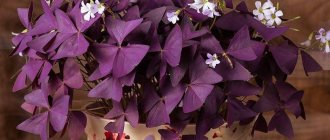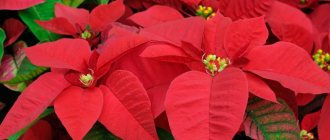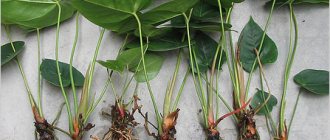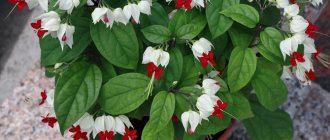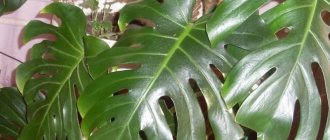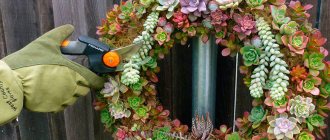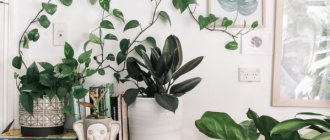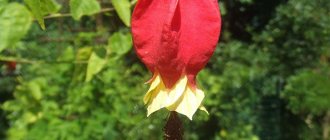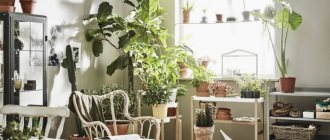Nowadays, plants of unusual colors, especially red, are gaining popularity, and we are not talking about the color of the flowers themselves. Plants with red leaves look fresh, bright, beautiful, interesting, they can charm at first sight and decorate any room. By the way, the red color appears due to anthocyanin pigments. There are a lot of ideas on how to decorate your home or work space with such plants! You can make a green corner by immediately combining different crops with green and red foliage, or create a simpler composition, or you can simply put one bright specimen in a prominent place.
Poinsettia
The beautiful poinsettia is also called Euphorbia most beautiful, Christmas star. A bright representative of the Euphorbiaceae. The most beautiful euphorbia is loved for its unpretentiousness and longevity - it is literally capable of delighting with its beauty for many years, requiring in return minimal but regular care.
Conditions for growing beautiful milkweed:
- Temperature: in summer about +20-25°C, in winter - about +16.
- Lighting: full, a south or south-east window is suitable.
- Watering: moderate, about 2 times in 7 days, in cold weather - 1 time in 3-4 weeks.
- Air humidity: normal, spraying with water is welcome, poinsettia can withstand dry air, but it has a bad effect on decorativeness.
- Pests: scale insects, spider mites, thrips.
- Reproduction: by apical stem cuttings.
Caladium
Thanks to its leaves, caladium looks more like some kind of extraterrestrial plant. It is distinguished by a combination of interesting colors and colorful veins.
Conditions for keeping and caring for caladium:
- Temperature: in summer - 20-25, in winter - 15-19.
- Lighting: grown in bright places that are protected from direct sunlight, comfortable on an east or north-west window.
- Watering: moderate, when adding moisture, do not allow water to get on the leaves, stops in winter.
- Humidity: high, regular spraying of the soil surface is recommended.
- Reproduction: daughter tubers.
- Pests: aphids, mealybugs.
- Feature of the culture: in the fall the leaves begin to die and in the winter the caladium is dormant.
Houseplants with spotted colors
What is the name of an indoor flower with long narrow leaves?
Many of the brightly colored varieties that exist are spotted or streaked. Such specimens also look interesting and have their admirers.
Codeium
A flower from the Euphorbiaceae family is picky about its conditions. That is why you rarely see it in an apartment or house. Feels great in greenhouses or winter gardens. It is a shrub that in natural conditions grows up to 3 m, in greenhouses it does not exceed 1.5 m. It has several subspecies that differ from each other in the color of the crown. On the red background of the foliage there are spots of yellow, orange and white. Veins of contrasting color are always present. This makes the plant even more interesting.
Codeium
Note! It should be kept in good lighting, but avoid direct sunlight. Provide regular watering. It is better if the pot is placed on a tray with pebbles moistened with water. During flowering, additional spraying is required.
Cryptanthus
The flower, native to Brazil, belongs to the Bromeliad family. There are no stems, the leaf blade originates from the root base. The leaves are shaped like a starfish with a sharp edge. The color is bright: the base of the leaf is bright crimson with the presence of greenish or gray veins in the form of stripes.
Cryptanthus is unpretentious in cultivation. Heat-loving, loves high humidity and frequent watering.
Hypestes
A herbaceous perennial belonging to the Acanthus family. The foliage is red-green, covered with a spotted pattern in a chaotic form. It grows well, reaching a height of 50 cm. It has strong and hard stems, densely covered with foliage.
Hypestes
Loves frequent watering and good lighting. In shaded areas, the leaves turn pale and lose their attractiveness.
Important! Depending on the conditions of detention and the amount of fertilizing, hyposthes can change the color of the foliage.
All presented types of indoor plants with red leaves are original and have their own attractiveness. Each of them can dilute the interior of the apartment, becoming a bright accent. All that remains is to choose the plant you like and provide it with the necessary conditions.
Aglaonema
The evergreen exotic is a member of the Araceae or Aronicaceae family. Grows well in regular substrate and hydroponics.
Conditions for aglaonema:
- Temperature: in the warm period - 20-25 degrees, in the cold - 16-18, but not lower.
- Lighting: full, but diffuse, south-west or south-east windows are suitable.
- Watering: plentiful in the summer, reduced later, but you need to make sure that the soil in the pot never completely dries out.
- Humidity: high, requires spraying with warm water.
- Reproduction: seeds, apical cuttings, suckers, dividing the bush.
- Pests: spider mites, mealybugs.
Heuchera
This plant takes root well at home and in the garden. Maintaining a houseplant requires minimal effort and time, so it is recommended for beginners. For a neat appearance, it is necessary to promptly remove peduncles with fading flowers. If you trim the heuchera in time, the plant will form more and more buds. For pruning, it is recommended to use only sharply sharpened and sterile pruning shears.
If possible, in the summer it is better to take the heuchera out into the fresh air. But when ventilating, be sure to protect it from strong winds and rain. Young plants need regular watering to develop a strong root system.
In winter, the frequency of watering should be reduced. In the winter months, when kept in a cool room, the frequency of watering is reduced to a minimum. The optimal temperature is 20-23°C, but in winter the flower will tolerate temperatures of 5-10°C.
Cordilina
Cordyline leaves are highly decorative. Representative of the Sparzhevs. The crop can be grown in soil or hydroponically.
Features of growing Cordyline:
- Temperature: in summer - 20-25 degrees, in cold weather - not lower than 18, should be protected from drafts.
- Lighting: A bright place is suitable for variegated cordylines, but direct sunlight should be completely excluded.
- Watering: in summer, moisture should be added abundantly, avoiding drying out or waterlogging of the earthen clod; later they are reduced, but you should also not allow the soil to dry out.
- Air humidity: high, regular spraying is recommended.
- Reproduction: through seeds, division of rhizomes, cuttings.
- Pests: aphids, thrips, scale insects.
Perennial flower with red leaves
Bloom's Coleus is a perennial flower with red leaves in the middle.
The velvety leaves with finely toothed edges can come in all colors from cream, green, pink and purple to fiery red. The patterns on them are as varied as the shapes. Almost exclusively garden forms and hybrids of Coleus Bloom are grown as indoor plants. This flower with red leaves in the middle blooms with inconspicuous blue flowers.
Look at this indoor flower with red leaves in the photo and remember the name of the crop:
Family: Lamiaceae (Lamiaceae).
Homeland: Tropical Asia and Africa.
Location: a perennial flower with red leaves prefers a sunny location, otherwise the leaves will not have beautiful color.
Temperature: room temperature, in winter not lower than 12 °C.
Air humidity: the warmer the room, the higher the air humidity should be.
Substrate: flower soil mixture.
Watering: Abundant in summer, more economical at low temperatures; do not allow the earthen clod to dry out.
Feeding: Weekly in summer.
Transplantation: If necessary.
Reproduction of Coleus Bloom: Cuttings in water.
Pests, diseases: Red mite.
Important! The tops of the shoots are regularly broken off for more luxuriant growth. In the summer, expose the coleus to the air, but in damp and at the same time cold weather, bring it indoors.
Cryptanthus - home flower with red leaves
Cryptanthus acaulis has wavy red, pink or brownish leaves covered with gray scales collected in star-like rosettes. Cryptanthus bivittatus is characterized by wavy leaves with two white or pink longitudinal stripes.
Family: Bromeliaceae (Bromeliaceae).
Homeland of Cryptanthus: Brazil.
Location of home flower with red leaves: Partial shade, sunny in winter.
Temperature: Not lower than 18 °C. The earth must be warm.
Humidity: Tolerates dry air, but prefers 60% humidity. Do not spray.
Substrate: Flower soil mixture with styrene chips or something else.
Watering: Economical - in a funnel.
Feeding: In summer, every 2 weeks with fertilizer at a 50% concentration.
Transplantation: If necessary.
Reproduction: Offshoots half the size of the mother plant.
Pests, diseases: Rare.
Important! Cryptanthus should not be planted on a tree trunk as an epiphyte; it will die. Cryptanthus looks very attractive in the “bottle garden” and has a variety of uses.
Carefully! Contains substances that irritate the skin.
Coleus
Coleus has two strong advantages: firstly, it is unpretentious, and secondly, it is very colorful and beautiful. Many of them have interesting colors - green borders around the edges and a mottled middle. Representative of the Lamiaceae (or Lamiaceae).
In order for Coleus to please its beauty, it is necessary to satisfy its requirements:
- Temperature: in summer +18-20°C, in winter +12-14, not lower.
- Lighting: for maximum decorativeness, the crop requires full lighting, but direct exposure to rays should not be allowed, the light must be diffused.
- Watering: in spring and summer, abundantly when the top layer of soil in the pot dries, in the cold period it is reduced, but the soil should not be allowed to dry out.
- Air humidity: high, spraying will be beneficial.
- Pests: whitefly, spider mites, aphids.
- Reproduction: cuttings, less often seeds.
Oxalis (Oxalis)
Oxalis, oxalis, lucky clover, sour clover, hare cabbage - these are different names for the same plant. By the way, such names were chosen for a reason; the leaves of the representative of the Kislichny family are really sour. Flower growers are very fond of this crop for its colorful and delicate leaves that resemble butterflies. Oxalis is exactly the case when not only the color, but also the shape of the leaves causes admiration.
Some nuances that are important to know for successfully growing sorrel at home:
- Temperature: in summer 20-25, in winter - 16-18.
- Lighting: bright, but always diffused; direct rays can cause burns.
- Watering: plentiful, but the drainage system must be of very high quality, excess moisture is critical for it, during cold periods the amount of water decreases, you just need to maintain light moisture in the substrate.
- Humidity: moderate to slightly higher than normal room humidity.
- Pests: scale insects, aphids.
- Reproduction: by nodules or daughter bulbs.
Nidularium
Attractive because of its glossy, shiny, dense leaves. The highlight of nidularium is given by the bracts, colored red. Refers to Bromeliads.
The following conditions are suitable for decorative deciduous plants:
- Temperature: in warm weather +20-24°C, in cold weather +18-20.
- Lighting: partial shade, strong shadow and direct sunlight are not allowed.
- Watering: moderate, waterlogging should not be allowed; moisture should be added when the soil dries out. In spring and summer, it is recommended to add moisture through the leaf funnel, and in the cold period - in the standard way.
- Humidity: normal room humidity, in dry air you need to spray the leaves.
- Pests: scale insects, mealybugs.
- Reproduction: daughter rosettes.
Trees with red leaves
Red leaf maples
Norway maple Royal Red (Royal Red) is a tall tree with a wide pyramidal shape, reaching 15 m in height at maturity. The tree trunk is covered with dark brown bark with numerous shallow depressions. The tree is decorated with large five-lobed leaves, painted in a bright red color, which becomes even richer in the fall.
Norway maple Crimson Sentry reaches a height of 8 m and has a compact cylindrical crown up to 1.5 m in diameter. On short branches that shimmer silver in the sun, there are many reddish-brown leaves with a recognizable “maple” shape.
Decorative apple trees
Hybrid apple tree Royalty (Royalty) is a tree up to 5 m tall with a crown of about 3 m in diameter. The leaves are dark purple in color with a pronounced gloss. In May, the tree is covered with numerous bright pink flowers. And in September, charming apples appear. They are small, evenly round in shape and dark red in color, but not edible.
Decorative apple tree Royal beauty (Royal Beauty) is a tree with a weeping crown shape. In spring, the shoots are decorated with red-purple leaves, which, although they turn green in summer, retain a purple tint. In May, the crown is covered with flowers of a rich pink hue. The fruits are small red apples. The size of an adult tree depends on the height of the grafting and the method of crown formation.
Stunning beech trees with beet-brown crowns
Forest Beech Dawyck Purple (Davik Purple) is a tree with a columnar, dense, slender crown of thin, twisting branches growing upward. It grows up to 12m in height, but maintains a neat shape. The main advantage is the delightful, glossy purple-red leaves under the sun's rays. In autumn they turn purple-brown. Beech does not need shelter even at a young age, it can withstand slight shading and can easily tolerate dry summers. It grows slowly.
Beech Forest Purple Fountain. This tree grows slowly until the age of ten, then faster. By the age of twenty it reaches a height of 5m and 2m in diameter. The crown is weeping. The branches form picturesque cascades. In summer they have a purple hue, and in autumn they turn yellow. An ideal tapeworm for large areas and an accent tree in landscape compositions.
Unusual bird cherry with changing foliage color
Bird cherry virginia Shubert (Schubert) is a compact tree up to 6 m in height with an oval dense crown. In spring, it is decorated with bright light green young leaves and charming snow-white flowers. In mid-July, the foliage begins to turn red, acquiring a persistent purple-brown hue. During this period, young shoots with bright green foliage look impressive. By the end of summer, small round black berries ripen.
Bird cherry Siberian beauty (Siberian Beauty) is a tree up to 7m in height with a pyramidal crown. When blooming and during the flowering period, the leaves are colored light green, which changes to a different color from mid-summer. The upper side of the leaves turns dark purple and the underside turns purple. It blooms in May with neat snow-white flowers, exuding an incomparable, magnificent “bird cherry” aroma that fills the spring air. The flowers are collected in exquisite clusters that completely cover the tree.
Croton (Codiaeum)
Croton has attractive leaves. The codiaum flower is not particularly decorative; it is often simply torn off so that it does not take away excess energy. A representative of the Euphorbiaceae family has a truly fantastic color, combining several colors at once: red, yellow, green, pink, orange. This amazing combination will appeal to lovers of picturesque and rich colors. Codiaum also has an interesting feature - milky sap in the stems and leaves.
However, croton is demanding in care; it cannot be called unpretentious and unpretentious:
- Temperature: in summer +20-23, in winter +17-18, t should not fall below 17 degrees. It is also important to avoid any drafts.
- Watering: abundant in spring and summer, perform the procedure when the top layer of soil dries 1 centimeter. In winter, the introduction of moisture is reduced.
- Air humidity: high, it is necessary to regularly spray the leaves and clean them of dust.
- Lighting: should be full, but should be protected from direct rays. Therefore, it is better to place the pot on the east or west side.
- Pests: rarely affect due to the poisonous sap, but under unfavorable conditions (dry air) scale insects are possible.
- Reproduction: apical cuttings, air layering.
Home care
Air temperature
The best temperature for the plant is +22-25°C in summer, and +20°C in winter.
Important! When the air temperature is below +18°C, the leaves of the flower fall off. This culture does not like drafts or sudden changes in air temperature.
Because of this, in the summer, do not place the plant on the loggia, but leave it at home. In winter, do not place the crop near radiators.
Watering
The crop requires increased air humidity. Spray the flower from time to time with well-settled water. If the air is dry, then spray the flower twice a day.
Place the container with the flower on the tray. Pour pebbles or expanded clay into the tray. Pour water into the tray. From March to October, water the crop regularly with warm, settled water.
From October to March, gradually water less and less. But do not wait for the soil to dry completely, because if the roots of the fittonia dry out, the leaves of the flower will begin to fall off.
Attention! It is necessary that the soil in the pot is always somewhat moist, but excess moisture and stagnation of water should not be allowed, otherwise the roots of the crop will rot.
Air humidity is the main secret of good growth of fittonia:
Lighting
Important! Fittonia loves good lighting, but does not tolerate direct sunlight.
Therefore,
do not place the crop on a south-facing windowsill .
It is better to place Fittonia on western or eastern window sills. The flower can easily tolerate slight shading. In winter, with a lack of light, the leaves of the flower become less bright and saturated in color. Because of this, in winter you can illuminate the plant with fluorescent lamps.
Soil and fertilizer
The substrate for the pot is made by mixing 1 part humus, 1 part peat and 1 part sand.
From April to September, during the growing season of the crop, feed it constantly with mineral fertilizers. But since the flower can get sick due to excess fertilizing, their fertilizer concentration is reduced by 2 times compared to the dose that is written on the package.
Pots
Since the roots of the plant are shallow, choose wide and shallow pots.
Place drainage made of expanded clay, broken bricks, and small pebbles at the bottom of the container.
Rejuvenation
After 3-4 years, the culture needs to be rejuvenated . Cut off the longest branches, plant them in the ground and cover them with glass. After some time, the plant forms new side branches.
Transfer
The culture grows intensively, which is why in the spring the flower needs to be transplanted into a pot with a larger volume. It is better to replant young flowers annually.
Reproduction
Flowers are propagated by cuttings .
The shoots are cut into cuttings, then they are placed in moist soil, constantly sprayed and intensively watered.
When the cuttings have roots, they are transplanted into separate containers.
The crop is also propagated by dividing the bush or by seeds. In March, the seeds are sown in a container with soil, constantly watered, and placed in a room with an air temperature of +22°C.
Possible difficulties and illnesses
Pests that attack Fittonia are scale insects and spider mites.
Scale insects look like tiny, flat, oval insects with a hard shell. To eliminate insects, wipe the leaves with a solution of soap and then spray them with a 0.15% Actellik solution.
When a spider mite appears, you can notice whitish spots on the leaves; a cobweb is visible at the bottom of the leaves. In case of damage, it is necessary to spray the leaves with Fitoverm, Fufan.
Possible difficulties when growing a plant:
- If the tips of the leaves dry out and turn brown, this is due to too dry air.
- If the leaves turn brownish-yellow, then the crop does not have enough nutrients.
- With a lack of water, the leaves of the crop curl up and spots are visible on them.
- If the stems of a flower become limp and rot, this means that the air temperature is below 18°C and the air humidity is high.
- Also, when the air is too dry or there is too much water, the leaves of the flower fall off.
- If the crop is exposed to direct sunlight, then its leaves become less bright and they dry out.
Irezine
The compact bush amazes with its lush and colorful beauty. The variegated leaves are painted in an attractive beet red color.
Features of growing irezine at home:
- Temperature: in the warm period - 19-25 degrees, in the cold - 15-18.
- Lighting: the light-loving crop prefers full lighting; on a south window it is recommended to make it diffused.
- Watering: abundant (when the top layer of the substrate dries out), reduced in winter, but do not allow the soil to dry out.
- Humidity: normal, periodic spraying will be beneficial.
- Pests: aphids, whiteflies.
- Reproduction: stem cuttings.
- Feature of caring for irezine: you should periodically pinch the tops of the shoots to form a beautiful bush.
Types and varieties of Fittonia
Fittonia Mix
A compact perennial flower with foliage of various shades: from light green to emerald, has a network of bright veins of various shades. Fittonia mix is several varieties of plants that are planted in one container.
Fittonia Verschaffelta
This species has large dark green leaves with whitish, pinkish or scarlet veins. The stems of the crop are highly branched and the shoots are creeping.
The flower is up to 25 cm in height; it prefers moist and warm air. Most of the new varieties were bred by breeders based on Fittonia Vershafelt .
Fittonia Josan
This species has dark green leaves with olive-colored edges and brownish-red veins.
Fittonia Skeleton
It has creeping shoots and small, velvety leaves with a densely spaced network of red veins. Olive colored leaves.
Fittonia White Anna
The leaves of the plant are covered with a network of white-silver veins, and along the edges there is a bright green border.
Fittonia gigantea
The plant is quite tall compared to other types of Fittonia, up to 60 cm in height. It has velvety emerald leaves, somewhat compressed along red veins, up to 15 cm long.
Unlike other species, its stems are erect or slightly lodging. It hardly grows at home ; it survives only in an aquarium.
Fittonia White
The plant is similar to Phytlonia White Anna, but there is no border at the edges of the foliage, and the snow-white veins are quite thick.
Fittonia white-veined
A compact crop with an erect stem. It has oval light green leaves, they are slightly bent back, covered with silver-white veins.
Fittonia Red
It has dark emerald foliage and red veining.
Fittonia Perseus
This is a plant with light olive leaves, which are dotted with a network of dark pink veins.
Neoregelia
It is similar to Nidularium, but this is not surprising, because they belong to the Bromeliads. Neoregelia is attractive because of its beautiful glossy leaves and variegated bracts.
The conditions acceptable for neoregelia are simple:
- Temperature range: in summer +21-25°C, in winter - +16-18. It is very important that there is good ventilation and neoregelia has access to fresh air, but it should be protected from drafts.
- Lighting: bright diffused light without direct light.
- Watering: you need to pour water into the rosette of leaves, in winter - under the root.
- Humidity: high, it is recommended to use a humidifier or spray frequently. It is also important to remove dust from the surface of the leaves.
- Pests: aphids, mealybugs, bromeliad scale insects.
- Reproduction: daughter rosettes.
Cryptanthus
Cryptanthus is another striking representative of the Bromeliad family. The color of the leaves will appeal to lovers of unusual color combinations. The pattern also looks interesting.
The nuances of growing cryptanthus:
- Temperature: in summer 21-24 degrees, in winter 18-20, without drafts.
- Lighting: loves sunny, bright areas in the house, but without direct sunlight, very light partial shade is allowed.
- Watering: in spring and summer it is necessary to constantly maintain moderate soil moisture. It is important to avoid excess and lack of moisture. The main thing is stability, without sudden changes. In cold weather, the procedure is performed much less frequently; after the top layer of soil has dried, moisture should be added the next day. Water at the root, do not bring water into the outlet.
- Humidity: Cryptanthus needs high air humidity, which must be maintained constantly. An air humidifier or spraying several times every day will help.
- Pests: spider mites, thrips.
- Reproduction: by lateral shoots.
Small-headed Highlander Red Dragon
This plant will perfectly decorate a space in a semi-shaded area with moist soil. However, knotweed can infest a wide area if its growth is not controlled. Red-burgundy shoots and greenish-red leaves decorate the garden in summer, and small white flowers appear on the plant in late August - early September. Separated from the openwork leaves, they are unattractive, but against their background they add sophistication to the mountaineer.
Knotweed adapts well to drought and is undemanding to soil types, but in severe winters (especially with high humidity) it can freeze, so it needs shelter.
Maranta
An attractive feature of arrowroot is its bright red veins. The combination of scarlet, dark green and light green shades makes this decorative foliage plant stand out. Belongs to the Marantaceae family.
Conditions for growing tropical exotics:
- Temperature: in spring and summer +22-24, in winter and autumn +18-20. Protection from any drafts is important.
- Lighting: bright, but diffused light, but can withstand slight shading.
- Watering: during the warm period, plentiful, it is necessary to maintain moderate soil moisture, and the soil surface should not be allowed to dry out. In winter, the procedure should be performed less frequently; the surface of the top layer of soil should dry out.
- Humidity: high, it is necessary to regularly spray the arrowroot, and it is also useful to periodically clean it in the shower.
- Pests: spider mites.
- Reproduction: by dividing the bush, apical cuttings.
Begonia royal
The plant is also called Begonia Rex. It blooms rather inconspicuously, so flowering cannot be called the main trump card of a representative of the Begoniev family. The main beauty of the royal begonia is its variegated and luxurious leaves.
- Temperature: about 19-22 degrees, in winter - about 16.
- Lighting: bright, but the sunlight must be diffused; direct rays can cause burns to the foliage.
- Watering: abundant, you need to add moisture immediately when the top layer dries.
- Air humidity: normal or very slightly increased.
- Pests: thrips.
- Reproduction: through seeds, cuttings, division of the root system.
Hypoestes
Hypoestes belongs to the Acanthus family, it will decorate and enliven the decor of any room. Variegated leaves will appeal to lovers of variegated and unusual colors and patterns.
Features of hypoestes:
- Temperature: in spring and summer +22-25°C, in winter +17-18.
- Lighting: bright diffused.
- Watering: in warm weather, abundant when the top layer of soil dries. In winter, add moisture 1-2 times after the top layer of soil dries.
- Air humidity: high, spraying recommended.
- Pests: not susceptible.
- Reproduction: cuttings, through seeds.
As you know, red is the color of wealth and prosperity; it is believed that its presence in the house can attract success. It is possible that such thoughts have no basis in reality, but it is a reality, not a fiction, that color therapy works and with regular visual contact a person’s mood improves. Looking at a variegated houseplant with a red tint, you can lift your spirits, and a good mood - the key to good health.
